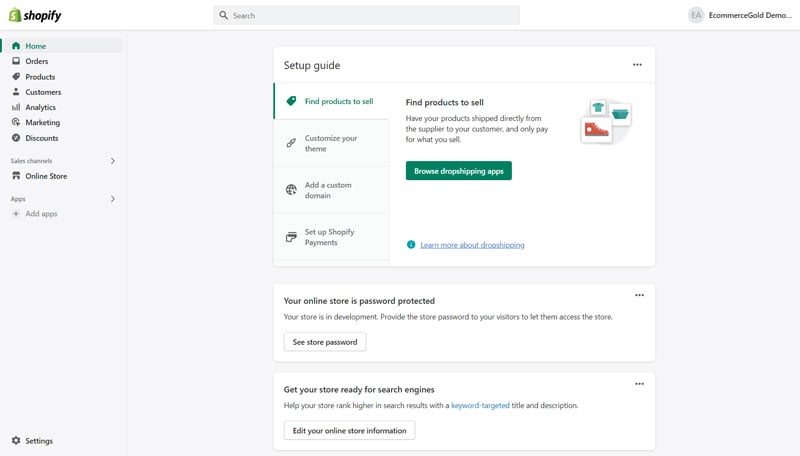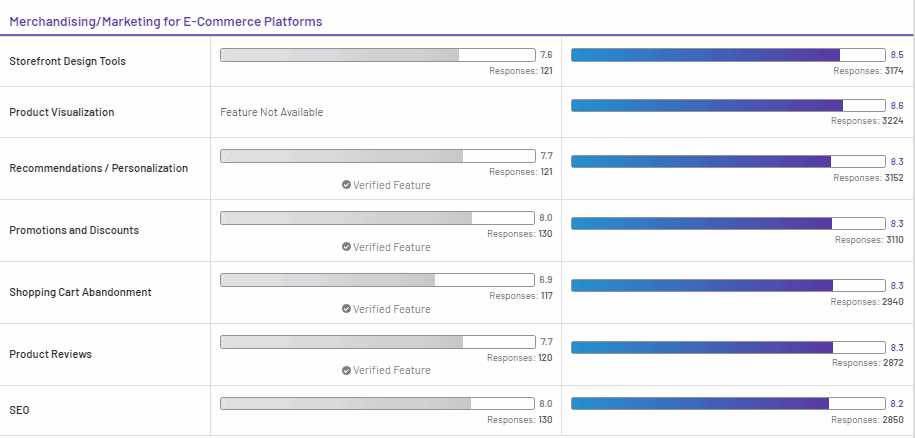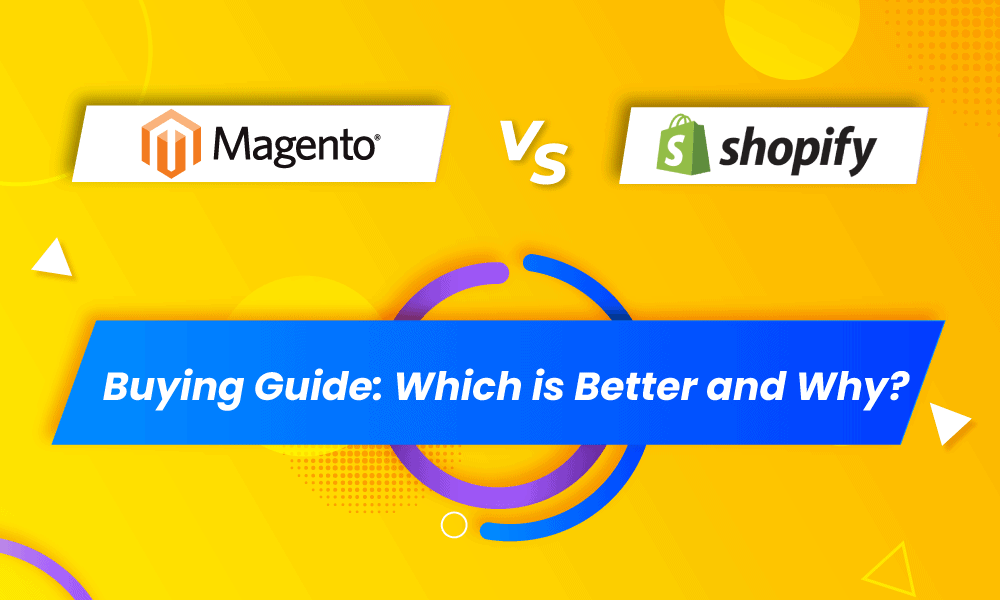Choosing the right eCommerce platform for your small business is a big decision. Any choice you make will impact growth over the long term. If you’re comparing Magento vs Shopify, you know that they both have powerful features. However, any decision you make would depend on whether you have the technical resources to customize those features to your business.
Besides the upfront costs of implementation, you’d need to factor in maintenance and upgrades, additional costs of scaling product lines or adding payment options, and so on. The deeper you go into these factors, the more complex it gets. But don’t worry, we’ve got the answers for you. In this post, we’ll compare the features, pricing, integrations, support, and everything there is to help you find the best fit for your needs.
You’ll learn:
- What is Magento and Shopify?
- Magento vs Shopify: Pros and cons
- Comparing Magento vs Shopify
- Which is better?: Magento vs Shopify
Let’s get started.
Table of Contents
What is Magento and Shopify?
Magento and Shopify are among the top eCommerce platforms on the market today. Here’s a quick introduction.
Magento
Magento is an open-source eCommerce platform that gives you complete freedom over website design and functionality. You have access to the source code which means you can customize any aspect of the core software. Magento is made up of modules that contain the basic features while extensions are add-on elements with specific functions. They’re both plug-and-play.
Magento is available in 3 versions- Magento Open Source, Magento Commerce, and Magento Commerce Cloud. In 2018, Magento was taken over by Adobe and its products have since been rebranded as Adobe Commerce and Adobe Commerce Cloud.
Magento Open Source (formerly Magento Community Edition)
This is a free-to-use version with limited features. You can set up a basic eCommerce website with it, including payments, shipping, marketing, and analytics.
Magento Commerce (formerly Magento Enterprise)
It is a premium version for large businesses with additional features. For example, it offers greater customization, product management, and marketing capabilities. You also get access to dedicated support with Magento Commerce.
Magento Commerce Cloud
In a nutshell, Magento Commerce Cloud = Magento Commerce+ Cloud. It provides scalability and performance advantages plus all of the features of Magento Commerce.
Shopify
Shopify is a hosted eCommerce platform that provides everything you need to build and launch your store in one place. That means it includes hosting and payment processing out of the box. Shopify comes with a drag-and-drop website builder and an app store with ready-to-use themes and extensions.
You can add all the features you need with a few clicks. You don’t need to know how to code or look for hosting elsewhere. Shopify Plus is a specialized version with increased performance and scale for larger businesses.
BigCommerce vs Magento: Features, Pricing, and More Compared
Comparing Magento 2 vs Shopify
Magento 2 has several enhancements over the baseline version. Magento Open Source and Magento Commerce are built on it. Magento 2 is more responsive and has an improved design and security features. Compared to Shopify, Magento 2 provides deeper customization but needs technical skills to use it effectively. On the other hand, Shopify has drag-and-drop functionality but you cannot modify the code.
Magento 2 requires third-party hosting and maintenance while Shopify is an all-in-one platform. Magento 2 is more complex and is better suited to larger businesses. On the other hand, Shopify is much simpler and works well for small businesses.
Magento Enterprise vs Shopify Plus
Magento Enterprise and Shopify Plus are both designed for the needs of large enterprise companies. They can support large transaction volumes. Magento Enterprise provides more customization options, while Shopify is a fully managed (less flexible) solution. In terms of scalability, support, and features, both are more or less evenly matched.
As you might expect, Shopify Plus is more expensive than the basic version. However, you don’t have to worry about hosting, development, and maintenance costs as with Magento.
Read also: WooCommerce vs Magento: A Complete, Unbiased Overview
Magento eCommerce vs Shopify
Magento Ecommerce (aka Magento Commerce) has unlimited customization possibilities but needs coding expertise. On the other hand, Shopify provides easy-to-use features but is limited by comparison. Magento can handle high volumes better due to being open-source. With Shopify, you’ll need a premium plan like Shopify Plus if you want to scale your business.
Shopify vs Magento Market Share
Shopify and Magento rank among the top eCommerce platforms today.
As far as eCommerce platforms go, Magento had an estimated market share of 2.37% with 68,088 active stores. On the other hand, Shopify stood at 16.93% with 486,617 active stores. Magento is preferred by enterprise businesses because it can be customized and extended to multiple applications with ease. Shopify is popular with small and medium businesses, thanks to its all-in-one capabilities.
16 Powerful Shopify Marketing Strategies To Stand Out in 2023
Magento vs Shopify: Pros and Cons
Let’s look at the pros and cons of Magento and Shopify.
Magento Pros
So, what are some of Magento’s most popular features?
1. Customization
As an open-source solution, Magento code can be modified any way you like to create custom workflows. It can be scaled quickly for higher transaction volumes, multiple languages, expanded product line –you name it.
2. Features and capabilities
You can create a personalized shopping experience with features like inventory management, custom checkout pages, omnichannel marketing (email marketing, loyalty programs, SEO, etc.)
3. Developer tools
You can leverage tools and resources like Magento Developer Documentation (customization tips) and Magento marketplace (app store) to get the best out of your software.
Magento Cons
Magento is open-source, so you can expect the following:
Learning curve
You need to know coding to set up, customize, and manage your site. This can be challenging for beginners unless you have IT support.
Higher cost
Magento Open Source is free to download but hosting, development, and support costs can quickly add up. Magento Commerce may be cheaper upfront compared to Shopify Plus. However, the extra costs could well tip the balance in Shopify’s favor.
Shopify Pros
On the other hand, Shopify is:
User-friendly
Shopify is easy to set up and manage. Thanks to the drag-and-drop website builder and template gallery, you can get your website up and running in hours.
Low cost
Shopify is an all-in-one solution that includes hosting and support. Though the final cost can vary as you scale, it generally works out to be cheaper.
Shopify Cons
Shopify lags behind when it comes to the following.
1. Limited customization
Compared to Magento, Shopify is less customizable.
2. Scale limits
Subscription fees and transaction fees increase as business volumes go up.
Read also: Top 7 Shopify Alternatives to Grow Your Online Business in 2024
Magento vs Shopify: Who’s It For?
Magento is better suited for large enterprise businesses with two or more stores and a high transaction volume. You can build multiple websites on a single installation and update inventory, manage promotions, and track reporting data.
Shopify is ideal for small and medium businesses, thanks to its all-in-one features and excellent support.
Find the Perfect B2B Ecommerce Platform for Your Needs
What Factors to Consider When Comparing Magento vs Shopify?
One must remember that Magento and Shopify represent two ends of the cost-capability spectrum. However, there are areas where they overlap. In this section, we’re doing a head-to-head comparison of their features, pricing, and capabilities.
Magento vs Shopify: Quick Overview
| Differentiators | Magento | Shopify |
| Type of Platform | Open-source | Hosted solution |
| Pricing | Free (Magento Open Source) and per-installation model (Magento Commerce and Magento Commerce Cloud) | Subscription-based model |
| Customization | Highly customizable | Limited customization compared to Magento |
| Scalability | Highly scalable (large volumes) | Scalable for small to medium-sized businesses |
| Hosting | Requires separate hosting | Built-in hosting |
| Themes and Templates | Wide range of free and premium themes available | Limited number of themes, but easy to customize |
| Apps and Extensions | Wide range of apps and extensions | Wide range of apps and extensions |
| Coding Knowledge | Requires coding expertise for setup and maintenance | No code platform |
| Payment Gateways | Supports multiple payment gateways | Built-in payment gateways, easy setup |
| Maintenance and Support Options | Documentation, third-party Magento developers, community support | Fully managed with 24/7 support |
| Ease of Use | Complex setup and customization process | User-friendly interface, one-click integrations |
| Sales and Marketing Tools | Comprehensive sales and marketing tools, including advanced features for SEO, email, product recommendations, etc. | Built-in marketing tools, including discounts, abandoned cart recovery, and email marketing |
Magento vs Shopify: Detailed Comparison
How do Magento and Shopify hold up in a feature-by-feature face-off? Let’s find out.
1. Ease of Use: Magento vs Shopify
Shopify is very easy to set up. All you need to do is enter your email address and answer a few basic questions. This will get you started on a 3-day free trial. The dashboard page gives you access to products, marketing, and customer data. You’ll see a set-up guide on signing up. This will give you a nice overview of the navigation menu and settings. You can update your settings via the dashboard page.

Setting up Magento is complex. Before you do anything, spend some time understanding the documentation. It will tell you everything you need to know about the server, hosting, and configuration requirements. If you’re a beginner, working with an experienced developer and installing it should be a smooth process.
2. Design and Themes: Magento vs Shopify
Shopify is known for beautiful, responsive (mobile-friendly) themes and a user-friendly website builder with drag-and-drop functionality. As of writing, there were 12 free and 171 paid themes to choose from. You can edit both types of themes in Shopify but the premium ones are more customizable so they can be worth the expense. With Magento, you get 3 free and 8 paid themes.
These can be customized extensively and turned into unique designs. However, you’ll need to have coding knowledge or developer support for that – more so than with Shopify. With Shopify, premium themes can cost anywhere between $140 to $400. Magento pre-built themes can cost up to $499.
3. Scalability: Magento vs Shopify
If you have a large transaction volume, Magento can be the better option. Its modular architecture provides fast load times and stable performance even during peak business hours. Magento Commerce takes its enterprise features up a notch. The key is to choose a hosting provider that can cater to your needs.
Being a fully managed platform, Shopify scales bandwidth automatically based on traffic. This means you can focus on your customers and not on managing servers. It also has a large number of apps you can integrate to streamline orders, payments, returns, and so on.

4. Sales and marketing tools: Magento vs Shopify
At the time of writing, most G2 reviewers rated Shopify as the better option for marketing and sales, thanks to tools like personalized product recommendations, promotions, cart abandonment, and SEO. Most of them are integral to the Shopify platform.
So there’s no need for installation or setup. However, if you do need specific tools, you can choose from among a wide range of third-party apps like Omisend, ReferralCandy, Oberlo, etc. Magento also offers similar sales and marketing capabilities like multiple shipping options, order management, payment processing, etc.
For example, Aheadworks or Landofcoder. However, these are available as modules and extensions that need to be installed and configured separately. While you can create unique marketing sequences in Magento based on the needs of your business, development and testing can take time.
5. Apps and Extensions: Magento vs Shopify
We’ve just looked at some of the third-party marketing apps available on Shopify and Magento, but they are only scratching the surface. Shopify offers many powerful apps you can use to deliver a smooth user experience. These include:
- Livechat and customer support apps like Gorgias, Zendesk Chat, and Re:maze
- Inventory management apps like TradeGecko, Stocky, and Veeko
- Shipping and fulfillment apps like Shippo or EasyShip
- Content marketing and upsell apps like Yotpo, and Reconvert
By connecting apps like these, you can automate the entire customer journey and generate higher engagement and sales. You can use Shopify Flow to automate routine tasks like order management.
On the other hand, Magento gives you access to:
- Catalog management apps like Amasty Product Feed and Mageplaza
- Payment gateways like Authorize.Net, PayPal, Stripe, etc.
In general, Shopify apps and extensions can be customized or integrated more easily. This is because it has a simpler architecture. However, you have to consider development and ongoing maintenance costs. Add to that subscription fees for premium apps. With Magento, you have a lot more room for customization.
You can modify the code to fit specific workflows and even build brand-new apps. However, development can take more time and cost more money.
6. Pricing and Transaction Fees: Magento vs Shopify
Shopify uses a subscription-based pricing model while Magento has per-installation pricing. Here’s what you can expect to pay:
Pricing: Magento vs Shopify
Shopify offers 3 different plans apart from a free 3-day trial.
Monthly Plans: Shopify Basic for $39/mo, Shopify for $105/mo, and Shopify Advanced for $399/mo.
Yearly Plans: Shopify Basic for $29/mo, Shopify for $79/mo, and Shopify Advanced for $299/mo (25% discount over monthly plans).
Shopify Plus: This enterprise version costs $2,000/mo and provides custom features and access to a dedicated support team.
Plans can be changed or canceled at any time.
What’s included
Basic: You get access to basic reports, inventory tracking across 1,000 locations, shipping discounts of 77%, and 2 staff accounts.
Shopify: Detailed reports, inventory tracking across 1,000 locations, shipping discounts of 88%, and 5 staff accounts.
Advanced: You get custom reports, inventory tracking across 1,000 locations, shipping discounts of 88%, and 15 staff accounts.
Magento
- Magento Open Source – Free
- Magento Commerce – $22,000
- Magento Commerce Cloud – $40,000
Extra costs
Magento plans do not include hosting except Commerce Cloud. You’d also have to pay for things like SSL certificates, domain names, premium themes, and add-ons. The total cost depends on the level of customization you need. Also, you need to factor in support and maintenance.
With Shopify, hosting is taken care of but there are other costs like domain name, themes, too. While support is free on all plans, you may need custom development from time to time. Besides, paid apps can have support fees of their own.
Transaction fees
Shopify charges transaction fees only if you use a third-party payment gateway and that’s anywhere between 0.5% to 2% depending on the plan. If you’re considering Magento, be sure to ask about transaction fees as there’s no public information available.
Bandwidth charges
There are no bandwidth charges with Shopify. However, Magento users may need to pay for additional bandwidth depending on the hosting provider they choose.
So, Shopify is a better option for SMBs as most costs are known. Magento hosting and development costs can vary from provider to provider.
Payment integration
Shopify provides a built-in payment processor called Shopify Payments. However, you can also choose from over 100 other processors like PayPal or Stripe. Magento does not come with a default payment processor. However, it supports a wider range (150+) of third-party processors compared to Shopify.
12 eCommerce Analytics Tools for Pro-Level Business Tracking
Which is Better: Magento vs Shopify?
If you’re launching an eCommerce business for the first time, an all-in-one solution like Shopify can help you get started faster. It has user-friendly features and flexible pricing. As a fully managed platform, you don’t have to worry about site performance or software updates. That makes it ideal for businesses with limited technical knowledge and a modest budget.

On the other hand, if you are looking for ways to innovate and compete with established eCommerce players, Magento’s scalability, customization, and flexibility make it a compelling choice. You can better optimize your online store for performance (site speed, responsiveness), customer experience (dynamic content, checkout), and compliance (fraud protection).
Read also: The Best CMS for eCommerce in 2024 [Pros, Cons, Pricing]
Conclusion
We hope we’ve made your job of choosing the right eCommerce platform easier. Nothing beats first-hand experience, though. So sign up for demos and free trials and evaluate each platform for yourself. We also recommend leveraging verified reviews and ratings on sites like G2.
This should help you make a balanced choice that pays off in the long run.
FAQ
1. Is Magento good for beginners?
If you don’t have coding skills, you’ll need to bring on developers to customize the functionality of your Magento store. You’ll also need to buy hosting separately.
2. Is Shopify a good place to sell?
Shopify makes it easy for small businesses to set up shop and start selling right away. It needs little to no training and streamlines operating costs.
3. Does Magento cost more than Shopify?
Yes, Magento is more expensive than Shopify. This is because it offers better scale and customization flexibility. It can help large businesses create innovative workflows and customer experiences. The trade-off is higher lifecycle costs.
